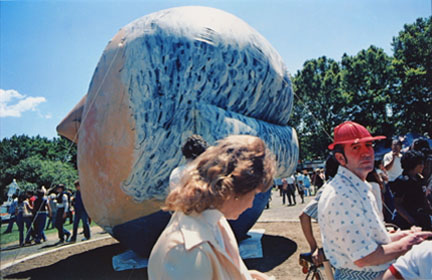About the Photographer
Babis, Larry
American, b. 1949
Photographers have been using various color processes for more than a century. Color film went on the market in the mid-1930s, but it was only in the 1970s that color photography came to be accepted as an art form. Along with better-known photographers like William Eggleston, Joel Meyerowitz, and Stephen Shore, Larry Babis was part of a rising generation who embraced color and overturned the longstanding notion that it was a lowbrow medium. Up to that point color was strongly associated with advertising and photojournalism, and the myth persisted that only black and white photographs achieved the qualities of art. Color photography's apparent coming of age in the 1970s is partly a matter of being christened by influential museum curators like John Szarkowski, who organized a pivotal exhibition of Eggleston's color photographs at the Museum of Modern Art in 1976. However, the creative work of Babis and his contemporaries played a major role in paving the way for the later predominance of color photographs in museums and galleries.
After photographing New York's residential neighborhoods, Larry Babis broadened his focus to examine the American social landscape on a larger scale, and in 1976 he began to travel and photograph throughout the United States. The basic subject matter of his pictures ranges from fairly ordinary places, like a nondescript street in New Jersey, to surreal scenes of people whose actions and preoccupations seem to demonstrate aspects of the era's cultural mentality. In one photograph from 1975, for example, a man plays a zebra-striped piano in a room full of taxidermy animals. If there is an ironic or absurdist quality to Babis's work, his photographs are just as often understated, flirting with banality. He employs a deliberately casual style that mimics the imprecise compositions and technical flaws of amateur snapshots, for example, by shooting at off-center angles or using an overly bright flash. In this regard, his photographs are not only about American life in the 1970s, but they also deal with the operations and peculiarities of the photographic medium at large.
Larry Babis was born in New York City in 1949 and completed a BFA at Cooper Union in New York in 1975, where he studied with Joel Meyerowitz, Tod Papageorge, and briefly with Garry Winogrand. His work was included in New Color: A Decade of Color Photography, a 1981 group exhibition curated by Sally Eauclaire at the International Center of Photography, New York. His work has also been exhibited at Cooper Union, New York, NY (1975); the Rochester Institute of Technology, NY (1976); Bard College, Annandale-on-Hudson, NY (1977); and the Photographers’ Gallery, London, UK (2002). His work is included in several books edited by Sally Eauclaire: The New Color Photography (1981), New Color / New Work: Eighteen Photographic Essays (1984), and American Independents: Eighteen Color Photographers (1987). Babis’s work in The New Color Photography was made with the support of a 1977 National Endowment for the Arts Individual Photographer’s Fellowship. His work is in the collection of the Smithsonian American Art Museum, Washington, DC, among other institutions. Babis has lived in Missoula, MT, since 1985.




